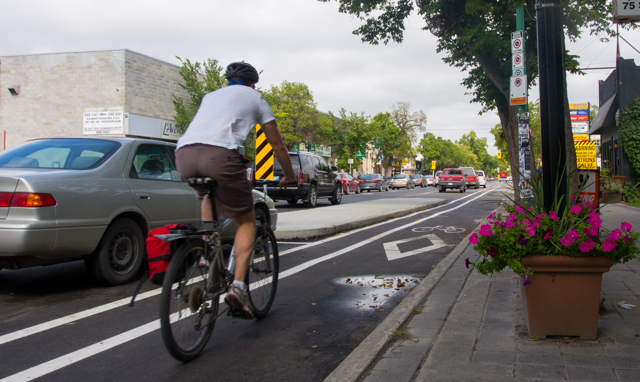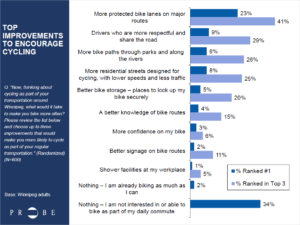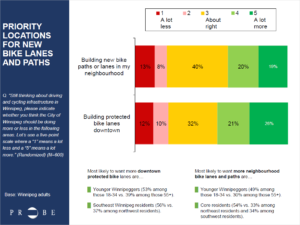First of three-part series focuses on Winnipeggers’ appetite to bike & obstacles preventing use to commute
WINNIPEG, July 24, 2018 – CAA Manitoba and Bike Winnipeg have partnered on a survey, conducted by Probe Research, to delve deep into the problems and the potential regarding Winnipeggers cycling to get around town. The surprising results reveal that not only is cycling becoming more mainstream in Manitoba’s capital city, but that Winnipeggers have an appetite to bike even more often – if infrastructure conditions are right.
“CAA and Bike Winnipeg have been talking about how to make our city more bike-friendly for years,” said Liz Kulyk, corporate manager of government and community relations at CAA Manitoba. “Yet we kept coming back to the same questions, which is why we needed to hear directly from Winnipeggers about their needs, desires and the obstacles that are keeping them from getting on their bike.”
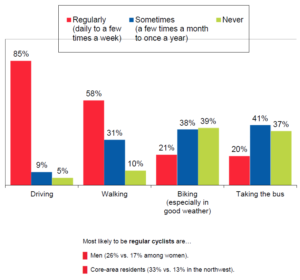
People are riding their bikes more than ever in Winnipeg, with 21% reporting that they ride daily or a few times per week.
A solid 21 per cent of Winnipeggers polled said they are already cycling daily or a few times a week for transportation – the highest self-reported usage that Bike Winnipeg has seen to date.
“It’s fantastic to hear more people are choosing to use two wheels to get around than ever before,” says Mark Cohoe, executive director of Bike Winnipeg. “But we’re even more excited about the fact that there’s still room to grow that mode share – 45 per cent of people saying they would cycle a few times a week or more if the conditions were optimal would put us on par with some European cities. Winnipeggers have told us loud and clear that they’re willing to bike, if there’s a way.”
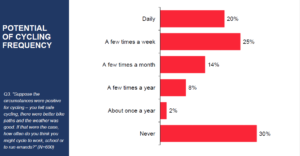
Given a safe. comfortable network to get them to their destinations, 45% of respondents said they would be encouraged to cycle daily or a few times a week.
When asked to consider and rank options that would get them moving, literally and figuratively, from an aspiring cyclist to an active user, one improvement quickly rose to the top of the list: more protected bike lanes on major routes. Additionally, in a related question, almost half (47 per cent) of respondents said building protected bike lanes downtown should be the city’s priority.
“When it comes to infrastructure, it’s clear that what’s good for cyclists is good for drivers. Safety for all road users increases when we separate cars and bikes,” says Kulyk. “Winnipeggers obviously feel the same way, and this is not the first time they’ve spoken out in favour of separated infrastructure. ”
Both advocacy groups agree that with a civic election just around the corner, city council candidates should prepare to have discussions with Winnipeggers about their plans to address active transportation.
“Record construction is great because every project is an opportunity to build for the future – not just with fresh pavement on an old outdated design, but to do what the young Winnipeggers who will inherit our city want and need,” Cohoe says. “We need to be considering improved designs that provide options for people of all ages and abilities to get around on foot or on bike as well as well as by car.”
The next release in the series delves deeper into the top safety concerns of local drivers and cyclists. The third instalment discusses Winnipeggers’ views on how the City of Winnipeg and elected officials must move road design and maintenance forward to benefit citizens and all road users for years to come.
Probe Research surveyed a random representative sample of 600 adults residing in Winnipeg between June 5 and 19, 2018. The survey sample size offers 95 per cent certainty that results are within plus or minus 4.0 percentage points of what they would be if the entire adult population of Winnipeg had been studied.
About CAA Manitoba:
Since its inception in 1904, CAA Manitoba has been a non-profit, member-driven organization that advocates for road safety and the Canadian traveler, however they choose to commute.
About Bike Winnipeg:
As a non-profit, volunteer-run organization, Bike Winnipeg advocates for increased cycling awareness in Manitoba and works to make cycling in Winnipeg a safe, convenient, accessible and enjoyable transportation choice year-round.
Revision Notes
A previous version of this article stated that 35% of respondents would be willing to bike daily or a few times a week given a safe, comfortable network and good weather. In fact, 45% of respondents had indicated they would bike daily or a few times a week under those circumstances.
